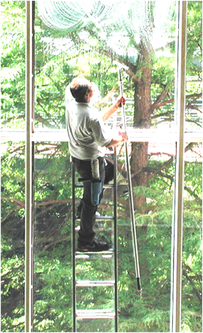
On March 25, 1911, the Triangle Shirtwaist Company factory in New York City burned, killing 145 workers. It took 18 minutes and 49 workers were burned to death or suffocated by smoke, 36 dead in the elevation shaft and 58 died from jumping to the sidewalks below. 2 more died from their injuries in the days following. (1.)
Ninety years later, The World Trade Center Evacuation Study: Factors associated with initiation and length of time for evacuation: found that 50% of the respondents to the study did not feel confident about exiting their building without directions from fire or security staff. 80% of the sample participants had a history of participating in a fire drill but only 10% reported that had ever actually entered a stairwell as part of the drill and only 6% had ever exited the building as part of a drill. Earlier the study mentions that the dynamics of high rise evacuation was not well characterized or understood. That fact was understood by the 1993 WTC bombing; when firemen conducted a final sweep through the towers, they found workers still at their desks six hours after the evacuation order was issued.” (2.)
Fire safety has come a long way with advances in material science, building codes and construction, engineering safeguards and evacuation routes and procedures. Still there are instances everywhere around us that could make those efforts useless.
The 2014 Las Vegas Consumer Electronics Show typically hosts well over 150,000 attendees. A friend of mine attended last year’s exhibition and sent me this picture. I do not know if there were any people on the other side of the doors of this conference room at that time. All the doors are marked “EMERGENCY EXIT DO NOT BLOCK.”
What would you do if you came across this actual scenario? Are you walking your facility spaces? How often? How do you note and communicate the almost certain changes a facility undergoes? I have known many safety professionals who do not leave their office until an event happens. Fire prevention is the safety professional’s job too. How do you train people to respond to an alarm?
A lot may depend on how reliable the facilities alarms are. If every time a false alarm sounded and your facility conducted a full evacuation it would not be long before the business bottom line is affected. The loss of production coupled with the cost of emergency response teams either company or public response adds up quickly. Earlier this year I was on a conference call with two individuals in another city. We had pretty much wrapped up the conversation when the fire alarm in their building began. Their response was to ignore it because according to both, “this happens all the time”.
In many cases today people consciously make a decision whether or not the alarm is actual prior to evacuation. I am not that different. The smoke alarm in my home will activate when I overcook a meal. My neighbor’s car alarm activates every time a delivery truck passes without fail. Truthfully, when was the last time anyone paid much attention to a car alarm? While I understand their reluctance to leave, I urged them to do so. It was most likely because two months prior a hotel I was staying at had both the audible and visual alarms sounding. Since I could not smell smoke what really motivated me was firemen equipment arriving on scene. From now on I walk down every motel exit, counting steps to the nearest, carry a small flashlight and will not make the mistake of failing to respond again.
Every person on every job site should be trained and equipped to recognize and appropriately respond to alarms. The safety professional should insist that evacuation training is conducted with participation drills, route designations, procedures communicated, vulnerabilities identified, and accountability measures are in place and at a minimum updated annually. AND WALK YOUR SPACES!
Critical factors in alarm training and response include building knowledge, shelter in place procedures, evacuation procedures, muster area designations, disabled employee contingency plans, and personnel accountability. Personnel accountability is critical because the last thing anyone wants is emergency responders re-entering a facility looking for someone who is not there.
(1) http://www.history.com/topics/triangle-shirtwaist-fire
(2) The World Trade Center evacuation study: Factors associated with initiation and length of time for evacuation.Robyn R. M. Gershon1,∗,†,‡, Lori A. Magda1,§ , Halley E. M. Riley1,¶and Martin F. Sherman2, Copyright _ 2011 John Wiley & Sons, Ltd.
Ninety years later, The World Trade Center Evacuation Study: Factors associated with initiation and length of time for evacuation: found that 50% of the respondents to the study did not feel confident about exiting their building without directions from fire or security staff. 80% of the sample participants had a history of participating in a fire drill but only 10% reported that had ever actually entered a stairwell as part of the drill and only 6% had ever exited the building as part of a drill. Earlier the study mentions that the dynamics of high rise evacuation was not well characterized or understood. That fact was understood by the 1993 WTC bombing; when firemen conducted a final sweep through the towers, they found workers still at their desks six hours after the evacuation order was issued.” (2.)
Fire safety has come a long way with advances in material science, building codes and construction, engineering safeguards and evacuation routes and procedures. Still there are instances everywhere around us that could make those efforts useless.
The 2014 Las Vegas Consumer Electronics Show typically hosts well over 150,000 attendees. A friend of mine attended last year’s exhibition and sent me this picture. I do not know if there were any people on the other side of the doors of this conference room at that time. All the doors are marked “EMERGENCY EXIT DO NOT BLOCK.”
What would you do if you came across this actual scenario? Are you walking your facility spaces? How often? How do you note and communicate the almost certain changes a facility undergoes? I have known many safety professionals who do not leave their office until an event happens. Fire prevention is the safety professional’s job too. How do you train people to respond to an alarm?
A lot may depend on how reliable the facilities alarms are. If every time a false alarm sounded and your facility conducted a full evacuation it would not be long before the business bottom line is affected. The loss of production coupled with the cost of emergency response teams either company or public response adds up quickly. Earlier this year I was on a conference call with two individuals in another city. We had pretty much wrapped up the conversation when the fire alarm in their building began. Their response was to ignore it because according to both, “this happens all the time”.
In many cases today people consciously make a decision whether or not the alarm is actual prior to evacuation. I am not that different. The smoke alarm in my home will activate when I overcook a meal. My neighbor’s car alarm activates every time a delivery truck passes without fail. Truthfully, when was the last time anyone paid much attention to a car alarm? While I understand their reluctance to leave, I urged them to do so. It was most likely because two months prior a hotel I was staying at had both the audible and visual alarms sounding. Since I could not smell smoke what really motivated me was firemen equipment arriving on scene. From now on I walk down every motel exit, counting steps to the nearest, carry a small flashlight and will not make the mistake of failing to respond again.
Every person on every job site should be trained and equipped to recognize and appropriately respond to alarms. The safety professional should insist that evacuation training is conducted with participation drills, route designations, procedures communicated, vulnerabilities identified, and accountability measures are in place and at a minimum updated annually. AND WALK YOUR SPACES!
Critical factors in alarm training and response include building knowledge, shelter in place procedures, evacuation procedures, muster area designations, disabled employee contingency plans, and personnel accountability. Personnel accountability is critical because the last thing anyone wants is emergency responders re-entering a facility looking for someone who is not there.
(1) http://www.history.com/topics/triangle-shirtwaist-fire
(2) The World Trade Center evacuation study: Factors associated with initiation and length of time for evacuation.Robyn R. M. Gershon1,∗,†,‡, Lori A. Magda1,§ , Halley E. M. Riley1,¶and Martin F. Sherman2, Copyright _ 2011 John Wiley & Sons, Ltd.


 RSS Feed
RSS Feed
